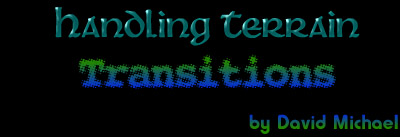11/10 - 11/12 @ Montréal, Canada
12/5 - 12/7 @ Shanghai, China
12/24 - 12/27
2/28 - 3/4 @ San Francisco, CA
More events...
2406 articles in the reference section.
Help us fight cancer!
Join SETI Team GDNet!

|
This article is another in my series of Tile/Map-based Game Techniques. In this article I discuss a method for handling terrain transitions on your main map display. First off, by "terrain" I am referring to the background or base layer of graphics for the map display. Terrain might refer to normal terrain types, such as grasslands or forests, but it is not limited to this. In a science-fiction game, for instance, the terrain could be bare metal or even the landscape features of another planet. The ProblemThe problem of terrain transitioning grows out of the need for a single type of terrain to be able to mesh with itself and still look good when placed next to another terrain. A forest tile should fit together with other forest tiles so that the forest proceeds seamlessly from one map cell to the next. But what happens when the forest tile is placed next to another type of terrain, such as mountains or grassland? Without some form "transitioning" the map looks very blocky and artificial. Figure 1: Terrain Without Transitions
One solution to the problem is to create specialized transition tiles that "blend" sections of each terrain into a single tile. However, the need for all terrains to transition into any other means that the number of specialized tiles escalates quickly. It may not be obvious at first glance, but the number of transitions required even between just 2 terrain types is quite large. On a square grid, there are 8 possible points of transition: one for each side and one for each corner. Even the simple forest-to-grassland transition would require 256 transitions, and this would have to be done for each terrain transition combination. If you have 9 or 10 terrain types, the amount of graphics this approach would require is unworkable. This can be refined some by using transitions with a transparent element, allowing for more variety with fewer tiles. The forest transitions would then be able to overlap any terrain. But 256 transition variations for each terrain type still seems pretty excessive. So how do you trim down the number of required transition graphics to a number that is more manageable? This is how we did it. |
|||||||||||
|
|
|||||||||||